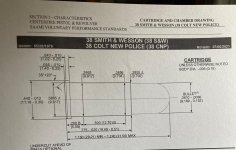Inland7-45
Member
- Joined
- May 16, 2021
- Messages
- 488
- Reaction score
- 651
I just got started on a run of .38 S&W. Brass is once fired Starline. I have switched from 158 gr Cast lead rd nose and Accurate #5 to the Missouri Bullet Co 145 gr lead round nose and W231 this time around.
Cases have been trimmed to .775" . The 158 gr RN had a crimping groove so nothing to decide on overall length.
Since the Missouri Bullet Co. 145 gr does not have a crimping grove this leaves some questions on best OAL . Lyman manual shows 1.240" max OAL. I believe this is for their 195 gr rn.
An ancient 145 gr Remington factory round that I have measured 1.189".
For my 20 round trial run this is where I set the OAL. After testing the trial run I will complete the remaining 480 prepped cases.
I would be interested in hearing from anyone who is using the Missouri 146gr. Has anyone on the forum confirmed what the ideal OAL should be when using the Missouri Co. bullet?
Also , I have just picked up 3lbs of W244 at a good price. Has anyone out there used W244 for the .38 S&W? Is there any source for published data for W244 and this bullet for the .38 S&W?
I will be firing the .38 S&W in an S&W BSR and a Colt Police Positive. I am having fun working with this caliber and I am looking forward to acquiring more revolvers in this caliber. First choice would be a J frame or later I frame.
Cases have been trimmed to .775" . The 158 gr RN had a crimping groove so nothing to decide on overall length.
Since the Missouri Bullet Co. 145 gr does not have a crimping grove this leaves some questions on best OAL . Lyman manual shows 1.240" max OAL. I believe this is for their 195 gr rn.
An ancient 145 gr Remington factory round that I have measured 1.189".
For my 20 round trial run this is where I set the OAL. After testing the trial run I will complete the remaining 480 prepped cases.
I would be interested in hearing from anyone who is using the Missouri 146gr. Has anyone on the forum confirmed what the ideal OAL should be when using the Missouri Co. bullet?
Also , I have just picked up 3lbs of W244 at a good price. Has anyone out there used W244 for the .38 S&W? Is there any source for published data for W244 and this bullet for the .38 S&W?
I will be firing the .38 S&W in an S&W BSR and a Colt Police Positive. I am having fun working with this caliber and I am looking forward to acquiring more revolvers in this caliber. First choice would be a J frame or later I frame.

